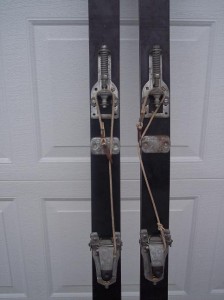I’ve noticed an increase in popularity of the old-style ski rack on cars. That is, the kind that clamp skis either in a single layer or in pairs. In recent years ski boxes seemed to have taken over that market with at least one on most vehicles in ski area parking lots and two boxes on some! However this year all the cars on my road with racks have the old-style!
Except me, that is! I just put our skis in the back of my hatchback. I do have a ski box which we have used on our Utah trips, but locally it’s more convenient to just load the skis in the back.
Back in the Retro-Ski days almost everyone had a roof rack. A contributing factor was that cars were different then. There weren’t SUVs or hatchbacks. There were station wagons, but they made up a small percentage of cars on the road. So roof racks were the way to go.

Which brings us to last week’s trivia question. In loading a roof rack, should the ski tips point to the front of the car or the rear?
RQ Mason answered “Tips in the rear! Am I the only one who knows this? I just threw out my Barrecrafters rack a year ago!”
Gretchen Besser remembered a convenient poem, “the old way of positioning skis atop, let’s say, a 1972 Chrysler, driving north up Rte. 17 from NYC to Belleayre, for instance, is this: Ski tips to the rear. Will prevent wind shear.”
R. Rafael also agreed that tips go to the rear. He says, “Still using my dad’s old A&T carrier bolted to Saab roof rack mounts. They are a little too wide because they were meant for a 1970s station wagon and 6 pairs of skis!” He did add that the tips should also be pointed down, in other words ski bottoms up. That introduces another whole controversy that I’m not going to get into.
The only dissenting position was Norma Stancliffe who said she used to load her roof rack tips forward. She does say she now carries her skis in the back of her car.
I was always a “tips to the rear” adherent, but I’m not going to offer any technical analysis of why that is the correct answer. No, I’m going to use it as an example of how certain things become “cool” or “in”.
By the way, I did come across an internet discussion on the technical aspects of the topic which went into more details than I could stand! It could have been the basis for a Masters’ dissertation. It compared all the possible combinations of skis flat or paired, tips forward or rear, bottoms up or down.
As I was saying, loading your skis into the roof rack with the tips to the rear was the “in” thing to do. Putting the tips forward labeled you as a “tourist” or even a “turkey!” This is just one example of the arbitrary criteria we humans introduce to judge others. And skiers aren’t immune from this practice.

Cubco Bindings with Safety Cord
What made you a “turkey” in the Retro-Ski days? The group I skied with always looked down at anyone with Cubco bindings. A skier could have had top of the line Head skis, but if they had Cubcos, they were still “turkeys”. I actually have a greater appreciation for Cubcos today as they were ahead of their time, but oh, those metal attachments on your boots!
Other perceived transgressions of the “cool” skier’s code included wearing sox over stretch pants, skiing in jeans, although my wife claims that was “cool” in New Jersey. Then there were those awful full face masks with the shiny silver outside! Well, at least you could use it on Halloween.
Today I’m not sure anyone cares about how you put your skis in the roof rack, but there is one differentiator that’s common between today and the Retro-Ski era: how you carry your skis. A few years back Teton Gravity Research shared a video called “Guide to International Ski Carrying.” It’s a riot. There’s the “bazooka”, the “hobo”, the “Oklahoma suitcase”, and of course the “local”. If you watch that video before the next busy day at the mountain, you can see how many of those carries you witness.
At this point I should point out that throughout this column I’ve used the very dated term “turkey” to describe someone who may not have a good understanding of their sport. Today they are called “Jerrys!” I felt I had better mention that lest I be labeled a “Jerry!”

January 8, 2021 at 11:37 am
Roof racks for skis are also safer than putting skis in the passenger compartment. In an accident, skis can become projectiles inside the car.